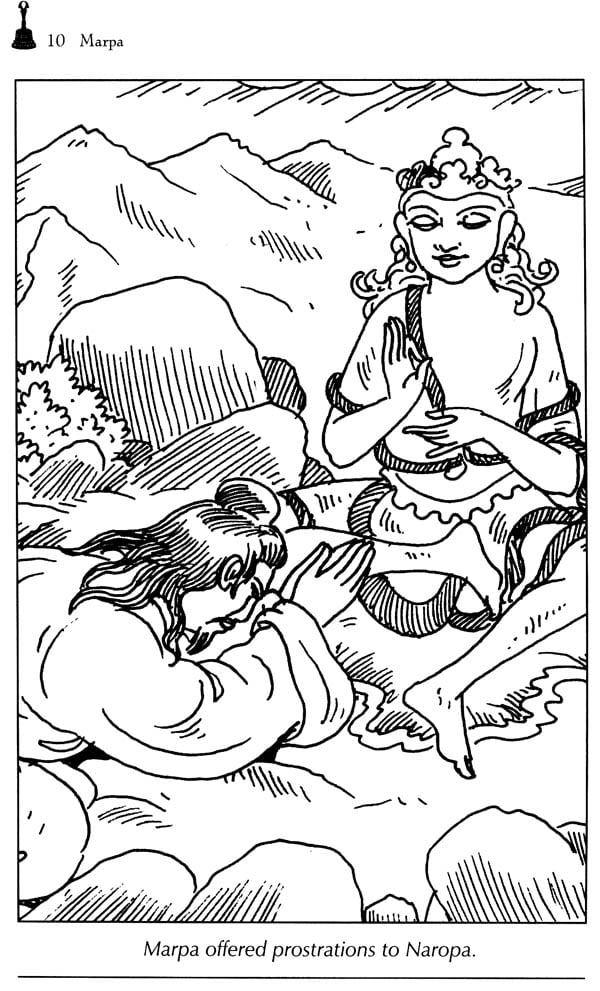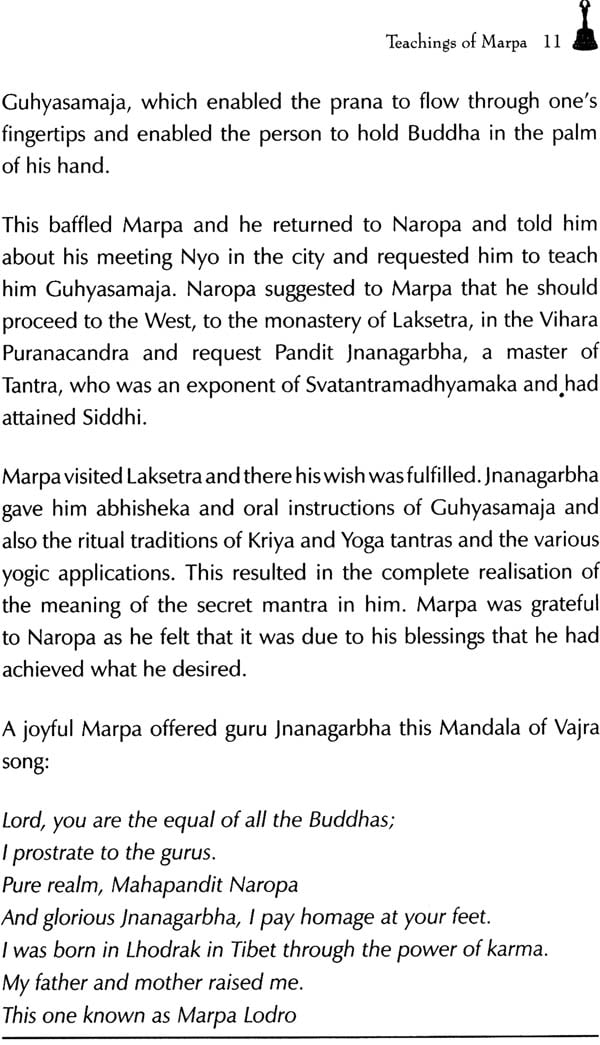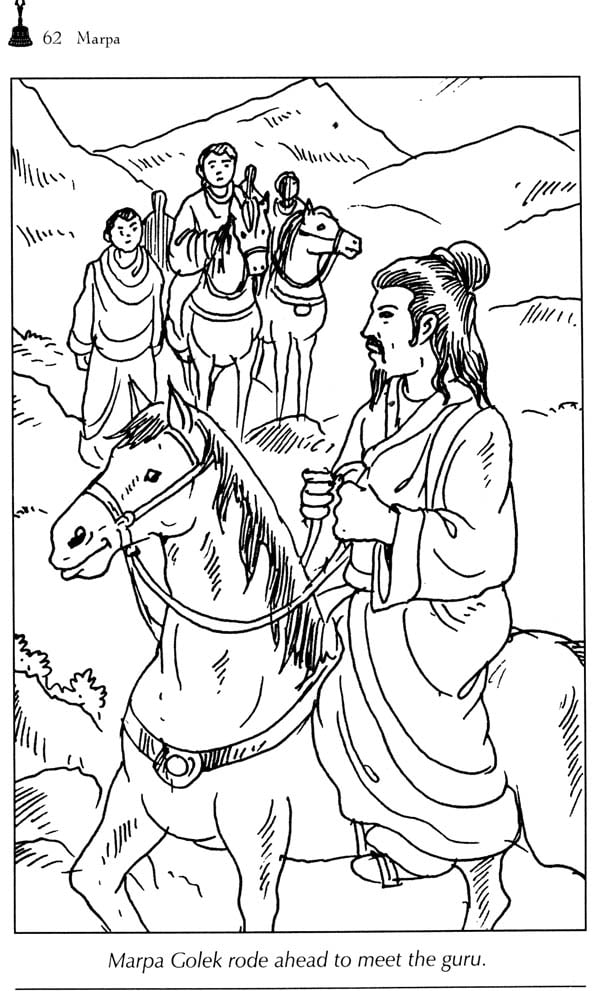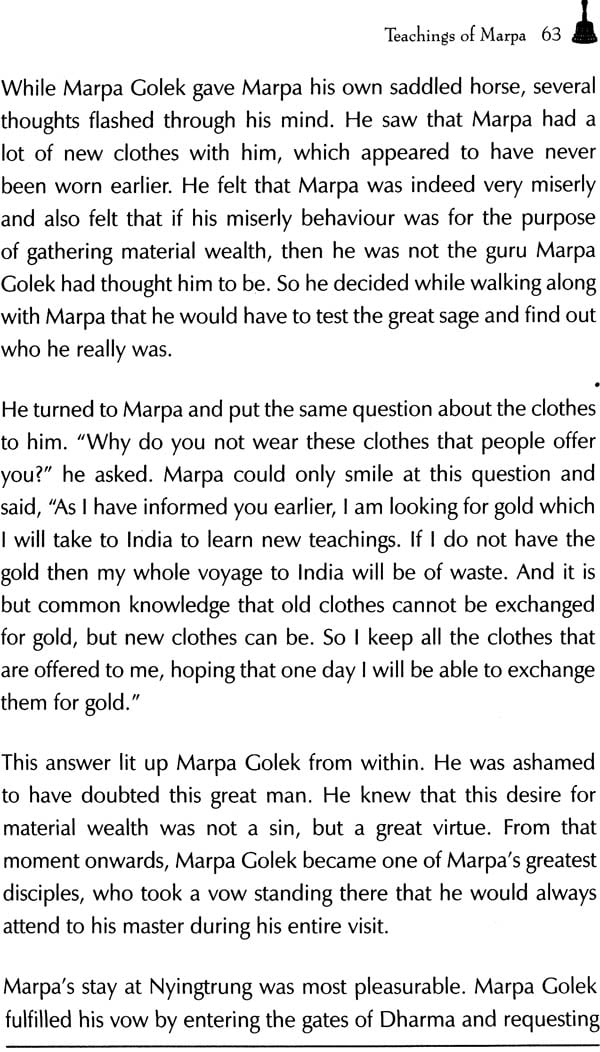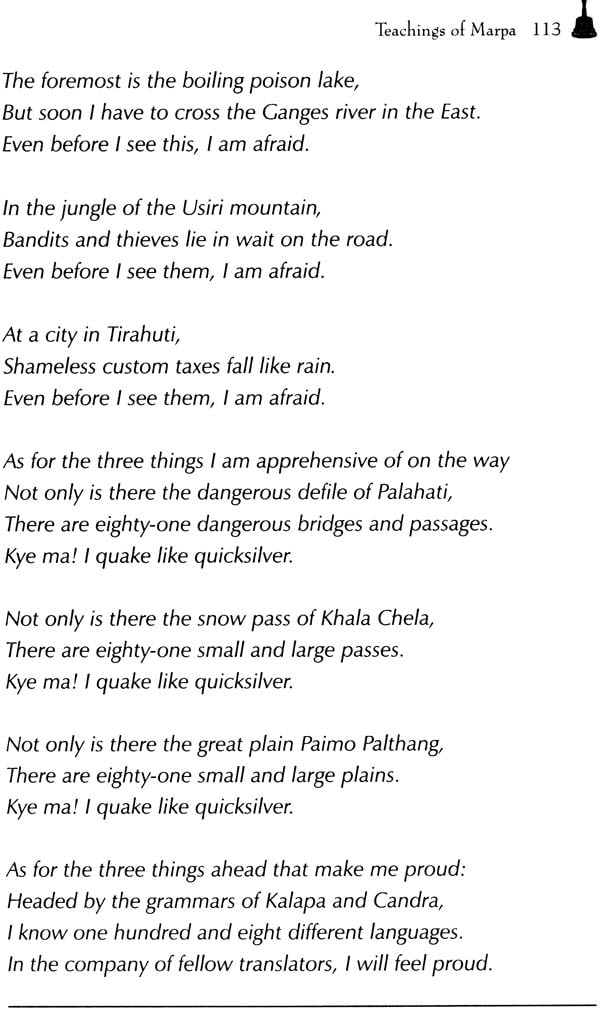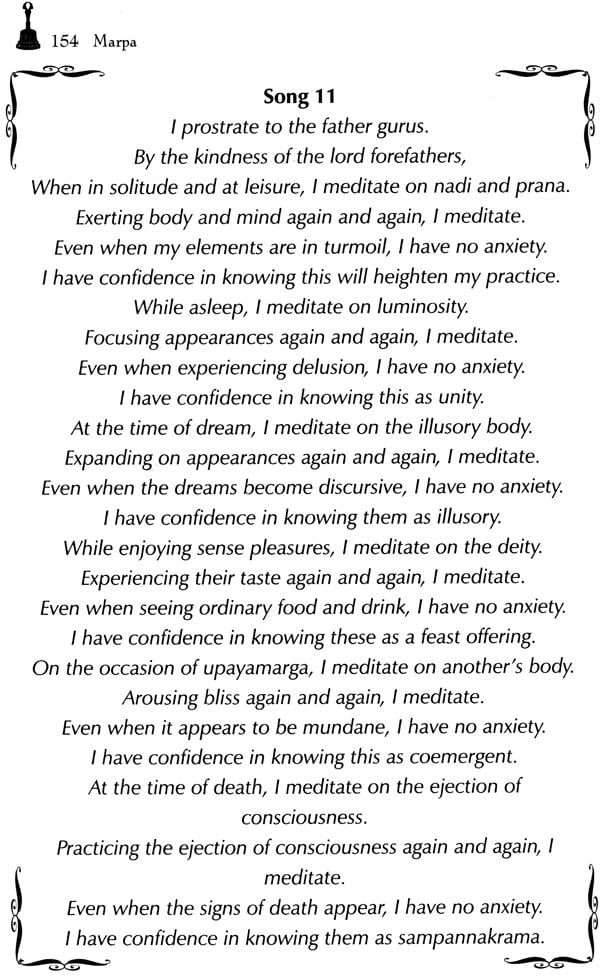
Buddhist Masters Marpa (Tibetan Translator Mystic)
Book Specification
| Item Code: | NAM535 |
| Author: | Jungney Lhama |
| Publisher: | Heritage Publishers |
| Language: | English |
| Edition: | 2010 |
| ISBN: | 9788170262633 |
| Pages: | 190 (11 B/W Illustrations) |
| Cover: | Paperback |
| Other Details | 8.5 inch X 5.5 inch |
| Weight | 270 gm |
Book Description
Marpa the Translator, the eleventh-century scholar and teacher, is one of the most renowned saints in Tibetan Buddhist history. Marpa is best known through his closest disciple, Milarepa. This book documents the fascinating life of Marpa, who, unlike many other Tibetan masters, raised a family while training his disciples.
As a youth, Marpa was inspired to travel to India to study the Buddhist teachings. This book narrates Marpa's three journeys to India. Marpa endured many hardships, yet succeeded in mastering the tantric teachings, translating them and taking them to Tibet, and establishing the Kagyu Lineage, which continues to this day.
Marpa, as most others of his time, spoke through songs which are interspersed within this lucidly written biography. The evocative drawings help to understand the story better.
Tibetans carried the whole of Indian Buddhism directly from India to Tibet. Although early visitors to Tibet used the term "Lamaism" for Buddhism in Tibet, some scholars later criticized this term, as it suggests that Tibetans had invented a new Buddhism. They pointed out that Tibet had preserved the long tradition of Indian Buddhism in its entirety, and in that sense had not invented anything new. Tibetans preserved Buddhist teachings that had been handed down from the Buddha to Nagarjuna and Asanga up to Atisha, and then reached Tibet through various acharyas, masters, translators and Tibetan lamas. The most prominent master-translator among them was Marpa.
Although they kept this legacy of authentic Indian Buddhist teachings intact, Tibetans made a very significant contribution by developing Buddhism further. As a result, Tibetan Buddhism and Indian Buddhism are not identical. One key Tibetan contribution centres on the division of the Mahayana Buddhist teachings they had imported into sutrayana and mantrayana. There is no Tibetan equivalent for tantrayana; the term used in classical texts is mantrayana or vajrayana. The terms sutra and tantra are used to refer to two sections of the classical canon.
The sutra path of the teachings begins with the training in turning one's mind away from all worldly affairs and continues up through generating bodhicitta, or the mind of enlightenment, and training in the wisdom that sees ultimate reality. It encompasses the whole range of Buddha's teachings. This is not different from "Indian Buddhism."
The mantra path, or tantric teaching, is the second part of the teaching. It begins with receiving a tantric initiation, abhisheka, as this is the doorway to the vajrayana path. From that initiation one must proceed up to the highest point of attainment-union or integration (yuganaddha)-through the "generation stage" and the "completion stage". Thus, after receiving initiation one practises the appropriate sadhana or deity yoga. There are a whole range of practices that comprise the "generation stage", such as visualizing oneself as the deity and visualizing the whole atmosphere or environment as pure and divine in nature. The "completion stage" involves meditating upon the inner, subtle constituents of one's body, i.e. the channels, the winds (energy flowing through the channels), and the drops (particular substances flowing with that energy). These aspects comprise much more detailed and precise practices. These tantric teachings are also not different from "Indian Buddhism."
How then does Tibetan Buddhism differ from Indian Buddhism? Tibet's greatest contribution is the systematic combination of these two streams of Indian Buddhist teachings, sutra and tantra. Very often academic scholars say, "The Tibetans were great systematizers," meaning that Tibetans were very good at arranging various teachings and structuring them in a systematic presentation. Perhaps sometimes they overdid it. However, Tibetan masters were unique in developing a very systematic combination of these two streams.
It is not that when talking about tantra Indian Buddhist acharyas completely ignored sutra. Sutra teachings were present in the background. Again, when they presented sutra teachings, tantric teachings were implied. In the Tibetan tradition, however, sutra and tantra are more explicitly distinguished in texts. When lamas teach they emphasize the importance of their combination. This is referred to as: mdo sngags zung 'brel, or the "union of sutra and mantra." All the traditions-Sakya, Gelug, Kargyu, Nyingma-basically teach the combination of the sutra and tantra teachings.
Whereas in the Indian tradition there are not many texts which emphasize the combination of these two, in the Tibetan tradition it is emphasized in every text. Tsongkhapa's the Great Treatise on the Stages of the Path (Lam Rim Chen Mo), for instance, is basically a sutra teaching. Over 99% is devoted to the sutra teachings. At the end, however, Tsongkhapa mentions how to train specifically in the vajrayana. Here Tsongkhapa devotes a few lines to explaining that this is not all, finally you must enter the mantra path. This is one good example of the combination. In fact, you will find very few Tibetan texts which do not exemplify this combination. If you look at any of the teachings of Marpa, you will find it is basically mantrayana in nature, but the presence of sutrayana teachings is evident.
Another key contribution of Tibetan Buddhism is the development of the teachings on the guru-disciple relationship. The guru-disciple relationship is an important subject in Indian Buddhism and also in all the traditions of Tibeten Buddhism. In Tibeten it is called shay nyen ten tsul (bshes gnyen bsten tshul), a difficult term to translate. Literally this means "attending to the guru," and this phrase indicates that a disciple definitely needs a teacher.
The central place Tibetans give to teachings on the guru-disciple relationship is illustrated by the layout of the Great Treatise on the Stages of the Path to Enlightenment (Lam rim chen mo). There are only two divisions: after the preliminaries it first discusses, "How to attend to a spiritual master," and then, "How to actually engage in the practice." This two-fold division is like the practice of putting two loads on a horse in the olden days: on one side is the guru- and on the other all the rest. They both have equal weight. Inspirational examples of this relationship that are often cited in all the traditions of Tibetan Buddhism are those of Marpa with his guru Naropa, Naropa with Tilopa, and Milarepa with Marpa. When I was a novice student at Drepung Monastery, the biggest Gelukpa monastery in Tibet, during the New Year vacations it was customary for a senior monk to read out Milarepa's biography to the others every evening, to inspire them towards guru-devotion and austerity.
Tibetan lamas are sometimes shy about discussing the guru-disciple relationship because they think it may look as if the first emphasis is on the guru or the speaker himself. The teachings on the guru- disciple relationship, however, are emphasized in scriptures and commentaries, and the tradition of following that practice is very much a living tradition, so we cannot pretend it is not there. What is important is to understand the main purpose of this emphasis on the guru-disciple relationship.
Marpa Lostsawa, sometimes known as Lhodak Marpa Chokyi Lodro or commonly as Marpa the Translator was a Tibetan Buddhist teacher credited with the transmission of many Buddhist teachings to Tibet from India including the teachings and lineages of Vajrayana and Mahamudra.
Marpa enthusiastically sought Buddhist instruction in India. Although he eventually became a highly accomplished Buddhist master; Marpa neither founded nor joined a Buddhist institution, choosing instead to remain a married householder" landowner and businessman.
Born in Lhodrak Chukhyer in the southern part of Tibet, to an affluent family, Marpa began studying at a young age but was wild and untamed compared to other children. Marpa first received instruction for three years at Mangkhar with Drokmi Shakya Yeshe and mastered Sanskrit. He decided to travel to India to study with renowned Indian Buddhist masters. Marpa returned home to Lhodrak and converted his entire inheritance into gold to fund his travel expenses and to make offerings to teachers.
Marpa journeyed first to Nepal where he studied with Paindapa and Chitherpa, two famous students of Naropa. Paindapa later accompanied Marpa to Pullahari, near Nalanda University, where Naropa taught. Marpa spent twelve years studying with Naropa and other great Indian gurus. After twelve years he set forth on his journey back to Tibet to teach and continue his dharma activities.
Marpa travelled to India twice more and Nepal three more times and studied with Naropa and other great teachers including Maitripa. On his third visit to India, Naropa, who was engaged in tantric practices, proved difficult to find. However, eventually Marpa found him and received the final teachings and instructions from Naropa. It was then that Naropa prophesied that family lineage would not continue for Marpa, but that his lineage would be carried on by his disciples. Marpa now had received the full transmission, so Naropa formally declared Marpa to be his successor although he had other major disciples including Paindapa, Chitherpa, Sri Santibhadra or Kukuripa, and Maitripa.
Upon his return to Tibet, Marpa spent many years translating Buddhist scriptures and made a major contribution to the transmission of the complete Buddha-dharma to Tibet. Marpa continued to practice and give teachings and transmissions to many students in Tibet. After his third visit to India Milarepa became his disciple, who inherited his lineage in full. Marpa lived with his wife Dagmema and their sons in Lhodrak in the southern part of Tibet.
Contents
| Preface | V |
| Introduction | XIII |
| Early Years | 1 |
| Marpa's First Journey to India | 5 |
| Marpa in India | 8 |
| Mahamaya, the Mother Tantra | 15 |
| Naropa and Maitripa | 23 |
| Marpa- Path to Realisation | 32 |
| On the way to Tibet | 37 |
| Parting of ways | 43 |
| Marpa's Dream | 47 |
| Marpa in Tibet | 56 |
| Marpa the Great Master | 59 |
| Marpa's Second Journey to India | 69 |
| Marpa Returns to Tibet | 80 |
| Last Trip to India | 91 |
| In Search of Naropa | 96 |
| Going Home | 110 |
| The Final Years | 116 |
| Teachings of Marpa | 131 |
| Glossary | 164 |
Sample Pages
